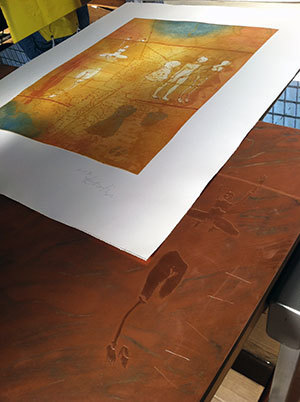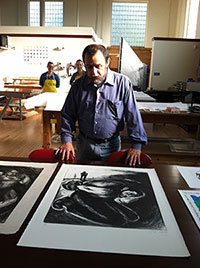Jill Lerner and Jessica O’Hearn are used to working on the weekends.
The master printer and production printer, respectively, at the Segura Arts Studio at the University of Notre Dame have been busy working with artist Claudia Bernardi to create an intaglio print — created by marks etched into copper plates — and, now, produce it.
 Claudia Bernardi’s print on top of the copper plates used to make it
Claudia Bernardi’s print on top of the copper plates used to make it
Lerner and O’Hearn were busy at work in late September, spreading orange and blue ink over copper plates and painstakingly rubbing the colors into the etchings on the plate. Each plate takes about an hour and a half, Lerner said, and Bernardi’s artwork uses five plates and 15 colors to create the finished piece.
Once the colors are on the plate, Lerner and O’Hearn carefully line up the plate with blank paper and roll them through a machine that presses the ink into the paper. After five runs through the press, the finished result is a piece of art.
Bernardi was the first artist to visit the Segura Arts Studio since the University purchased the studio and moved it from Arizona, where Joe Segura started it 30 years ago, to the Notre Dame Center for Arts and Culture on South Bend’s West Side. An internationally known artist from the California College of the Arts, Bernardi came to Notre Dame to work with Segura on the first print to be created by the studio in its new home.
Doug Franson, the studio’s assistant director, said Bernardi’s past features strongly in her work. “She worked with the Argentine forensic anthropology team, and they would go to atrocity sites and would dig up the remains and try to figure out and document what happened,” he said. “That really has an effect on her work.”
The piece the studio is producing features skeletal figures with map lines in the background, surrounded by warm colors of orange, yellow and blue.
“You could be across the room and see those incredible colors, and it draws you in,” said Franson. “And as you get closer, you start seeing layers of things going on, and you start seeing skeletal remains, children’s clothing, shoes. So the point of her artwork is showing what she’s found at these sites and giving a story to these people that lost their lives.”
 Joe Segura in his studio
Joe Segura in his studio
Bernardi’s work fits in well with the mission of the Segura studio, which is to work with artists from traditionally underrepresented groups such as African-Americans, Latinos and women. The goal is to get their artwork in museums so that it can be seen by a broader public and be incorporated into the mainstream art market.
The printers will produce only 60 prints of this first collaboration. Some will go to museums and to people who purchased subscriptions to the studio’s art, and about half will be given to the artist as a payment for her work. The remaining prints will go on sale at the studio’s website, segura.com.
Artists are invited to the studio for the chance to collaborate with Joe Segura on creating a new piece of art. Once the artist settles on an idea, the studio works with the artist to make the idea a reality.
“The studio is focused on producing works of art that are creatively significant — works that are both culturally important, and have value to collectors,” said Joe Segura.
“Most artists aren’t necessarily printmakers, they’re painters, drawers,” said Franson. “They come here and collaboratively figure out how to turn their work into something that can be an edition. It requires that collaborative experience with the master printer and production printer to work together to create the prints.”
The studio has invited six artists to come in its inaugural year at Notre Dame. Carrie Mae Weems, an American photographer who addresses issues that face African-Americans today, will be the second visiting artist. Weems is a 2013 MacArthur Fellow, which has granted her $625,000 over the next five years to use on her art. She will be working with the studio in the first week of December.
In early 2014, the studio will welcome four more artists. Claudio Dicochea, a painter and educator from southern Arizona, will be arriving in January. Dicochea’s work focuses on mestizaje, or mixed race identity. Faith Ringgold will be coming from Englewood, NJ. Ringold is a painter, writer, speaker, mixed media sculptor and performance artist who is well-known for her painted story quilts. Enrique Chagoya will be coming from Stanford University, where he is professor of art and art history. Chagoya is a Mexican-born painter and printmaker who focuses on the changing nature of culture. Vincent Valdez will then arrive from San Antonio. Valdez was the youngest artist to have a solo exhibition at the McNay Museum in Texas. His work explores imagery that pertains to social and political statements.
The Segura Arts Studio hopes to have the artists also give a talk to students and to the community while on campus to share their experiences and connect with residents of South Bend.
For more information on the studio, visit Segura.com.
Contact: Doug Franson, 574-631-3143, dfranson@nd.edu